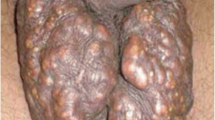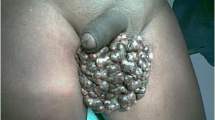Abstract
Background
Scrotal calcinosis is a rare idiopathic and benign condition, first described over a century ago by Lewinski. We report an exceptional case due to its size of a scrotal calcinosis.
Case presentation
Our patient is a 60-year-old African man with no remarkable medical history who complains of a large scrotal mass that has been evolving for 20 years and which had been causing discomfort and sexual problems. We performed a one-step surgical excision of the scrotal mass. Histopathological evaluation of the specimen confirms scrotal calcinosis. Calcium and phosphate blood tests are within normal range. There has been no recurrence after a one-year follow-up.
Conclusions
Scrotal calcinosis is a rare and benign condition whose treatment is surgical once diagnosed and has a good prognosis.
Similar content being viewed by others
1 Background
Idiopathic scrotal calcinosis is a rare and benign condition which was first described by Lewinski [1] over a century ago. It is characterized by deposits of calcium in the scrotum with unknown etiology although theories of its origin have been reported in the literature. It usually occurs in young male adults with no history of trauma, genitourinary infections, or hormonal disorders. Some cases on this condition has reported in the literature. Its treatment is surgical and the excision must be complete in order to avoid recurrence, which is rare. Malignant transformation of this condition has not been reported in the literature [2] Histopathological examination confirms the diagnosis of scrotal calcinosis. In this manuscript, we seek to report the first published case on scrotal calcinosis in Mauritania which is one of the largest if not the largest case to be found in the literature to our knowledge.
2 Case presentation
Our patient is 60-year-old African man farmer with no remarkable medical history who complains of a large painless progressively increasing scrotal mass evolving over 20 years. This mass had caused a feeling of heaviness in the scrotum making it impossible for the patient to have sexual encounters. Physical examination shows multiple mobile and confluent nodular lesions in both hemi scrotal skins with no anomaly palpated on each testes (Fig. 1). Calcium and phosphate tests were within normal range. We performed a one-step complete excision of a mass with an estimated weight of 1.7 kg (Fig. 2). The postoperative course was uneventful. Histopathological examination confirmed the diagnosis as scrotal calcinosis. The patient was able to resume normal sexual activity and gained esthetic satisfaction (Fig. 3). No recurrence was noted after a follow-up of 1 year.
3 Discussion
Scrotal calcinosis is a rare condition first described in 1883 by Lewinsky [1]. It generally occurs in patient between 30 and 50 years. However, some cases have occurred in infants and in elderly patients [2, 3]. The etiopathogenesis is not elucidated, although there are theories attempting to explain it. The most accepted theory is that the origin of calcinosis is a calcification of epidermoid cysts. According to this theory, the rupture of the epithelial layer initially surrounding the epidermoid cyst produces foreign body type inflammation followed by calcium dystrophy, thus constituting scrotal calcinosis (Fig. 4) [2, 4]. The calcium and phosphate tests are within normal range. Thus, it is believed to be an idiopathic condition. This is a painless, insidious disease affecting intimate areas which sometimes causes delayed diagnosis with sometimes the patient having to report to the hospital after several years after the condition began. In our case, the patient had waited for 20 years before seeking medical assistance. The surgical management of this condition is unequivocal. It consists of complete excision of the nodular lesions. The goal for this treatment is functional, esthetic and pathological [5]. The results are generally excellent, and recurrences are rare but a few cases of recurrence are reported in the literature. There are no published cases of malignant transformation of this benign entity till this date.
4 Conclusions
Scrotal calcinosis is a rare and a benign condition whose management is surgical once diagnosed with a good prognosis. This study reports the first published case in Mauritania.
Availability of data and materials
All data generated or analyzed during this study are included in this published article.
References
Lewinski HM (1883) Lymphangioma der Haut mit verkalktem Inhalt. Virchows Arch Pathol Anat 91:371–374
Karray O et al (2017) Scrotal calcinosis: two case reports. J Med Case Rep 11:312. https://doi.org/10.1186/s13256-017-1451-8
Doh K et al (2015) Apport de l’histopathologie dans le diagnostic d’une calcinose scrotale: à propos d’un cas African. J Urol 21:80–83
Fassi MJ, Ammari JE, Khallouk A, Achour YF, Tazi F, Farih H (2003) Calcinose scrotale. Prog Urol 13:332–333
Kpatcha TM, Darre T, Tengué K, Botcho G, Saka B, et al (2015) La calcinose scrotale: une observation au Togo et revue de la littérature African. J Urol 23: 352–354
Acknowledgements
Not applicable.
Funding
The authors received no specific funding for this study.
Author information
Authors and Affiliations
Contributions
SA performed the surgery, wrote and designed the study. DM have been involved to revising it critically for important intellectual content and has given the final approval of the version to be published. DA helped performing the surgery, have been involved in drafting the manuscript and revising it critically, and has given the final approval of the version to be published. CJ made critical assessment of the article and has been involved in drafting it and has given the final approval of the version to be published. All authors read and approved the final manuscript.
Corresponding author
Ethics declarations
Ethics approval and consent to participate
No ethics committee approval was required at our institution for this case report involving a limited number of patients.
Consent for publication
Written informed consent for publication was obtained from the patient.
Competing interests
The authors declare that they have no competing interests.
Additional information
Publisher's Note
Springer Nature remains neutral with regard to jurisdictional claims in published maps and institutional affiliations.
Rights and permissions
This article is published under an open access license. Please check the 'Copyright Information' section either on this page or in the PDF for details of this license and what re-use is permitted. If your intended use exceeds what is permitted by the license or if you are unable to locate the licence and re-use information, please contact the Rights and Permissions team.
About this article
Cite this article
SOW, A., Diagana, M., Diop, A. et al. Giant idiopathic scrotal calcinosis: an exceptional case report in Mauritania. Afr J Urol 28, 23 (2022). https://doi.org/10.1186/s12301-022-00292-9
Received:
Accepted:
Published:
DOI: https://doi.org/10.1186/s12301-022-00292-9








